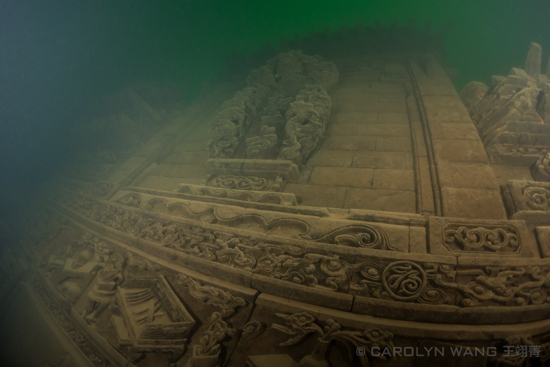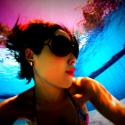Dive the Ancient Ruins of Lion City in Qiandao Lake

Deep below the calm surface of Qiandao Lake in the Zhejiang Province of China lie the mysterious ruins of two ancient cities, dating back to the Han and Tang dynasties.
The Origins of Lion City
Qiandao Lake, also known as Thousand Island Lake, is a sprawling body of fresh water, covering 573 sq. km. The name comes from the fact that there are over a thousand islands in the lake. Qiandao Lake was created in 1959 when the valley at the base of the Wu Shi (Five Lion) mountain was flooded to create the Xin'anjiang Reservoir and Xin'an River hydroelectric station.

Aerial view of Qiandao Lake. Photo by Chinese National Geography.
This was a massive government project that forced 290,000 people to relocate their homes as more than 1,300 villages and tens of thousands of acres of farmland were flooded and submerged. In addition to the direct impact on the local residents, two ancient cities located in the valley at the foot of the mountain were also submerged into the lake.
It is believed the city of Shi Cheng (also known as Lion City, named for Wu Shi mountain) was built during the Tang Dynasty in 621 AD, making it nearly 1,400 years old. Based on records of the region’s history, it is thought to be quite large, possibly over 60 football fields, and featured 265 arches throughout the city. Shi Cheng was also unusual in that it was constructed with 5 city gates and towers, as opposed to the norm of 4. The city of He Cheng is believed to date back even further to the Han Dong dynasty (25 -200 AD).
The cities lay undisturbed at the bottom of the lake, until recent rediscovery and exploration starting in 2001. The early divers found Shi Cheng to be largely intact, with many of the structures, carvings, guardian lions, and arches still preserved. There have been efforts to map & document Shi Cheng by divers and researchers, as well as looking into protective measures to prevent damage to it. In January of 2011, the cities were declared historical relics under the protection of the Zhejiang Province.

A closer look at one of Lion City’s many intricate carvings.
Getting There
There are very few dive operators running trips to Qiandao Lake. I opted to dive with Big Blue Scuba, based in Shanghai, as they have scheduled trips to dive the lake. In addition, Shanghai has a wide range of travel and accommodation options, along with many international and domestic flights to either Pudong Interational Airport (PVG) or Shanghai Hongqiao International Airport (SHA).
The Qiandao Lake dives were offered as a weekend package, including round trip transport between Shanghai and the lake, the dives, tanks and weights, food, and local accommodations. Nitrox and rental gear is available if needed.
Qiandao Lake on Google Maps.
From Shanghai it is approximately 400km to the small town of Dashuzhen near the southwestern edge of the lake, taking between 6-7 hours by car. It was actually only 4 hours to reach the eastern edge of Qiandao Lake, however, you will still needed to navigate the local winding roads around the lake (some of which were still under construction) to reach the hotel in Dashuzhen.
Another option is to contact the Beijing Dragon Diving Club to see if they have any upcoming Qiandao Lake dives. Members of the club were the first to rediscover the underwater city in 2001.
At the Lake
Dashuzhen is a small and remote town with a handful of local shops and vendors. We stayed at a small hotel that was just 10-15 minutes by van to the dive staging area and boat dock. The hotel was fine for dive purposes (sleeping & showering) but it is definitely more on the adventurous of the accommodation scale. So if you choose to dive Qiandao Lake, be aware that you will not find any 4-star hotels near the dive sites. It should also be noted that most of your food options while in Dashuzhen would be traditional Chinese dishes, prepared from fresh, locally farmed ingredients. This will undoubtedly thrill some people, while less adventurous eaters may have a tougher time.
The Dives
Because this is a lake dive, it is important to understand the differences between the conditions encountered here vs. clear ocean water. All divers were required to do an initial checkout dive in the lagoon, which only reached around 25ft in depth. Visibility at the surface was 5ft at best, dropping down to a mere 6 inches in some places at the bottom of the lagoon. This quickly made us realize how quickly the visibility could deteriorate, how easily you could become separated from your guide and how disorienting the conditions could become. If any group members had lapses in buoyancy or improper kicking technique that disturbed the low solubility sediment at the ruins, the dive could be completely destroyed for everyone.

Panoramic view of the calm waters of the lagoon at Qiandao Lake where we conducted our check out dive.
The dive boat can hold 6-8 divers and was docked in the lagoon near the dive staging area where we prepped our gear and suited up. Bathrooms and showers are located at the staging area as well. The Lion City dive sites are about 10 minutes by boat from the dock, and we dove as a group of 3 with our guide. The lake itself becomes dark very quickly as you descend, and dive lights are mandatory as it essentially becomes a night dive as you near the ruins, which lie between 85 – 130ft below.
Related pages - dive resort raja ampat, professional underwater cameras, chemistry hobbies, blackwater diving, underwater strobe

Your first glimpse of the ruins of Lion City will take your breath away. Clear structures appear out of the dark waters as you approach with your lights. Thankfully the visibility at the ruins was much better than in the lagoon, topping out around 20-25 feet.

The beautiful city structures rise above you, covered with extensive carvings.

The upper right edge of an archway in Lion City.

Lion City (Shi Cheng) has been submerged in Qiandao Lake for over 50 years since the building of the Xin'anjiang Reservoir and Xin'an River hydroelectric station in 1959.

Another close up view of the ruins. Remarkable detail considering Lion City dates back nearly 1400 years to the Tang Dynasty.

A gorgeously detailed dragon and phoenix in Lion City.

It’s amazing to see the rich, 3-dimentional detail characterizing the carvings on the city structures.

Free from the damages of sun, wind and rain, the lake has preserved the ruins relatively free of growth and intact.

Panels and carvings cover nearly the entire surface of this Lion City wall.

While it can be easy to stay fixated only on the animal carvings in the city, Chinese characters can also be seen carved into the walls, giving further context to the city.

Another section of intricate carvings and Chinese characters on the city walls.

Detailed carvings adorn the top of one of Lion City’s 265 archways.


As we explored further, you could see some of the ruins have begun to topple over time.

Our guide getting a close up look at some of the looser stones from city structures.


Photo left: Both stone and wooden structures are visible at the ruins. The water actually preserves the wood quite well. Some wooden beams that were recovered from Lion City during earlier dive expeditions quickly became damaged as they dried and shrank in the air.
Photo right: Interspersed amongst the structures, it was eerie to see the remnants of the trees that used to line the city when it was above water.
When To Go
Generally, April – October are the recommended months to visit, as there is warmer weather at the lake, and hopefully warmer water below the thermocline. The colder air temperatures Nov – March can make it uncomfortable for divers to do 3 dives in a day, particularly those diving in wetsuits. Depending on the time of year, the water temperature can range from 45-60F (7-16C).
During my visit in early May, the air temperature was in the upper 70s to low 80s, with the surface water temperature in the low 70s – quite manageable upon entry. However, the water quickly dropped to a chilly 48F/8C below the thermocline.
For exposure protection, those diving wet first got into 3mm full wetsuits, and then had to contort themselves to get another 7mm wetsuit over it for 10mm in neoprene total, plus gloves and hoods. Even with that protection, several of the divers chose to cut their dives short either due directly to the cold temperature, or because they were consuming their air more quickly than usual from being cold while in the water.
I dove in a drysuit with similar undergarment layers to what I would wear in Southern California waters, and did not have any issues with the cold water temperature during the dives. I definitely recommend using a drysuit if you have one, particularly if you’re planning to do these dives for photo or video and are looking to maximize your dive time. After all, if you come this far to see the underwater cities, I don’t think you’ll want to cut your exploration short.

A last look at Lion City.
Photo Tips & Gear
Treat this like a night dive and bring lights, lights, and more lights. There is almost zero ambient light when you reach the ruins down at 85-130 feet. You’ll need lights for navigating, spotting/focusing your camera, and strobes or video lights. Don’t bother with a macro lens; a mid-range lens or wide-angle lens will be your best bet. Just keep in mind that if you choose to shoot wide-angle, you will be fighting with the sediment in the water and limited visibility of no more than 20-25 feet, so it can be difficult to get a shot without any backscatter.
The photos in this article were taking using a Sony RX-100 in a Recsea housing and a UWL-04 fisheye wet lens with dual Sea & Sea strobes. The video was filmed on a GoPro Hero 3 Black edition with two Sola video lights.
For more gear links, view underwater photo gear by category, photo gear by brand, underwater housings by camera, and underwater gear buying guides.
VIDEO: Diving Qiandao Lake & Lion City Ruins:
Filmed by Carolyn Wang and edited by Lawrence Wang.
Further Reading
RECOMMENDED ARTICLES
SUPPORT THE UNDERWATER PHOTOGRAPHY GUIDE:
The Best Service & Prices on u/w Photo Gear
 Visit Bluewater Photo & Video for all your underwater photography and video gear. Click, or call the team at (310) 633-5052 for expert advice!
Visit Bluewater Photo & Video for all your underwater photography and video gear. Click, or call the team at (310) 633-5052 for expert advice!
The Best Pricing, Service & Expert Advice to Book your Dive Trips
 Bluewater Travel is your full-service scuba travel agency. Let our expert advisers plan and book your next dive vacation. Run by divers, for divers.
Bluewater Travel is your full-service scuba travel agency. Let our expert advisers plan and book your next dive vacation. Run by divers, for divers.






























